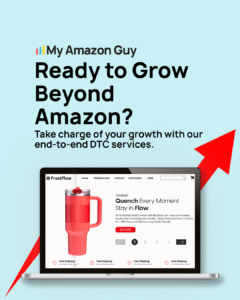Your DTC site doesn’t need more traffic – it needs a DTC CRO process that actually converts.
Only 11% of DTC companies are hitting $ 100 M+ in sales. That’s not for lack of ambition, but usually for lack of conversion strategy.
While Amazon gives brands a head start with built-in traffic and trusted infrastructure, the competition is brutal. Ads cost more. Margins shrink. And sellers often lose touch with their customers. Relying solely on Amazon isn’t just limiting, it’s risky.
That’s why our Amazon agency developed a DTC CRO process built to help sellers build real brand equity, increase conversions on their own websites, and take back control of their growth. Because if you’re not converting traffic off Amazon, you’re leaving money and long-term value on the table.
TLDR: This blog post explains that to truly drive sales on your Direct-to-Consumer (DTC) website, you need a robust Conversion Rate Optimization (CRO) process that transforms visitors into buyers, rather than just increasing traffic. This strategic approach helps diversify away from Amazon, boosts profit margins, and builds stronger brand loyalty for your business.
Below is an outline of what this article covers:
Table of Contents
Seize Your DTC Future – Act Fast!
It's time to build real brand equity and supercharge your direct-to-consumer sales with a custom conversion strategy designed for Amazon sellers.
What is Direct-to-Consumer (DTC) Conversion Rate Optimization (CRO)?
DTC CRO is the process of making your own website better at turning visitors into buyers. It helps you get more sales without needing more traffic.
Instead of relying only on marketplaces like Amazon, DTC CRO focuses on improving how your site performs. That means making the user experience smoother, faster, and more convincing for your customers.
Here’s what DTC CRO typically includes:
Clearer calls to action (like “Buy Now” or “Add to Cart”)
Faster site speed and mobile optimization
Better product images and descriptions
Streamlined checkout process
Testing what works best (like button color, layout, headlines)
Why smart Amazon sellers diversify and prioritize DTC CRO
The "Amazon-Only" Problem
Selling only on Amazon might seem safe, but it comes with big trade-offs. You give up control over branding, customer data, and have to deal with changing fees and tough competition.
As more sellers flood the platform, standing out is harder than ever. That’s why smart brands are branching out.
What happens without CRO
Many Amazon sellers launch a DTC site and spend heavily on ads, but see little return. This is the “leaky bucket” effect: traffic pours in, but sales don’t follow.
Why? Because what works on Amazon doesn’t always work on a DTC site like Shopify.
And with the average Shopify conversion rate at just 1.4%, weak performance means missed revenue.
What you gain from an optimized DTC channel
A strong, optimized DTC website gives you more control and better profit potential. Here’s what you get:
Higher margins without Amazon’s referral fees
Direct access to customer data
Full control over brand messaging and customer experience
A stronger foundation for customer loyalty and repeat sales
An optimized DTC site is also a goldmine for insights. You can see what customers like, what they don’t, and use that data to even improve your Amazon listings.
Why CRO is the missing link
CRO turns your site traffic into real sales. It stops the “leaky bucket” by fixing the gaps that cost you money.
With CRO, you make every visitor count. It helps reduce high Customer Acquisition Costs and boosts revenue without needing more traffic.
The My Amazon Guy blueprint: Our 8-phase DTC CRO process
My Amazon Guy uses a step-by-step, 8-phase process to help sellers grow their DTC websites. This roadmap is built for brands that want to grow beyond Amazon.
If you’re used to Amazon’s system, switching to DTC can feel overwhelming. Our structured approach brings clarity and makes the transition easier to manage.
What you can expect from our DTC CRO process
Our DTC CRO process isn’t a one-size-fits-all template. It’s a custom-built system based on years of hands-on experience with real brands.
We focus on what matters most to sellers like you. Our goal is to guide your DTC channel from setup to long-term growth.
A clear starting point with baseline audits and performance metrics
A structured path to reduce drop-off and increase conversions
Customized strategies to match your products, goals, and brand voice
A process that’s easy to follow even if you’re new to DTC
Proven methods that help turn traffic into loyal customers
The 8-Phase DTC Domination Plan: Your roadmap to higher ecommerce conversions
The journey to DTC success is mapped out in a clear, 8-phase process. Each phase builds upon the last, systematically enhancing a brand’s ability to convert visitors into loyal customers.
Phase 1: Discovery & strategy – laying the groundwork (week 1)
Goal: Set a clear direction for your DTC growth by aligning business goals, target audience, and tech stack.
Key Activities:
Kickoff Call: Align on goals and expectations
Brand & Product Audit: Identify strengths and gaps
Platform Assessment: Choose the right tech (Shopify, Woo, Amazon)
Customer Persona Workshop: Define your ideal buyer
Growth Strategy Roadmap: Establish benchmarks and next steps
Why it matters: This phase ensures every move supports your goals; without it, DTC efforts often miss the mark.
Phase 2: Tech stack setup & site design – optimize for conversion (weeks 2–3)
Goal: Build a fast, user-friendly Shopify or WooCommerce site optimized for trust and sales.
Key Activities:
Theme Customization or Full Build
Product Catalog Setup or Migration
Subscription Setup (Recharge, Bold, etc.)
Basic SEO & Clean URL Structure
App Integrations (Klaviyo, Postscript, GA4)
Why it matters: This phase sets up the tech and structure that power conversions and long-term growth.
Phase 3: Conversion & funnel buildout – engineering the customer journey (weeks 4–5)
Goal: Streamline the shopping experience to turn more visitors into buyers.
Key Activities:
Add Email & SMS Capture (popups, quizzes)
Optimize PDPs with UGC, Reviews & Bundles
Improve Checkout Flow (upsells, fewer steps)
Set Up Loyalty & Rewards Programs
Why it matters: This step transforms your site into a high-performing funnel that builds trust and drives more sales.
Phase 4: DTC brand launch prep & go-live – ensuring a flawless start (weeks 6–7)
Goal: Ensure your site runs smoothly, loads fast, and is ready to convert from day one.
Key Activities:
Final QA on All Devices & Browsers
Soft Launch for Internal Testing
Site Speed Optimization
Activate Email & SMS Welcome Flows
Prep Launch Announcement Campaign
Why it matters: A seamless launch sets the tone; no bugs, no slow loads, just a strong start that builds buyer confidence.
Phase 5: SEO, traffic & acquisition campaigns – driving qualified visitors (weeks 8–9)
Goal: Attract the right visitors who are most likely to convert, not just any traffic.
Key Activities:
Launch Paid Ads (Meta, Google, TikTok)
Set Up Influencer Seeding & Affiliate Programs
Build Retargeting Flows via Meta & Klaviyo
Add Amazon-to-DTC Inserts
Align Ad Messaging with On-Site Experience
Why it matters: Sending warm, qualified traffic makes your CRO work pay off—boosting conversions and ROI.
Phase 6: Analytics & reporting setup – measuring what matters (week 10)
Goal: Set up clean, reliable data systems so you can measure what’s working—and fix what’s not.
Key Activities:
Validate GA4 + Key Event Tracking
Set Up Weekly Dashboards (Looker, Triple Whale)
Define Attribution Strategy
Clean Up Tracking Pixels
Why it matters: Good decisions come from good data. This phase ensures you have full visibility to guide future CRO work.
Phase 7: Lifecycle & retention strategy – maximizing customer value (week 11)
Goal: Increase LTV and drive repeat sales through automation and continuous optimization.
Key Activities:
Set Up Email/SMS Flows (Abandoned Cart, Post-Purchase, etc.)
Implement Cross-Sell Automation
Build A/B Testing Plan (Emails, PDPs, Landing Pages)
Launch Ongoing Optimization Cycle
Why it matters: This phase turns one-time buyers into loyal customers, maximizing revenue and reducing acquisition costs over time.
Phase 8: Optimization & scaling plan – continuous growth and conversion optimization (week 12)
Goal: Turn initial wins into long-term, repeatable growth using data-backed decisions.
Key Activities:
Analyze CRO Data for Next Dev Sprint
Review Paid Ad Creative Performance
Evaluate Subscription and LTV Metrics
Set Retention KPIs & Future Roadmap
Why it matters: This phase ensures growth doesn’t stall. With a system in place, you can keep scaling and improving well beyond launch.
From Amazon Seller to DTC Leader.
It's time to leverage our comprehensive CRO expertise to build a powerful, profitable DTC channel that liberates your brand from marketplace limitations.
Real benefits of our DTC CRO process
Following a clear CRO process leads to real, measurable improvements in your brand’s performance. These gains directly support long-term growth and better profits.
Higher Conversion Rates, More Sales
The 8-phase CRO process helps more visitors complete their purchase. It removes roadblocks and improves persuasion across the site.
Many eCommerce brands see conversion rate jumps of +10% to +35% after proper CRO work. That’s a big win for sales without needing more traffic.
Fewer drop-offs in the buying journey
More customers completing checkout
Better use of existing site traffic
Bigger Average Order Value (AOV)
CRO doesn’t just get more sales, it also increases how much each shopper spends. With upsells, cross-sells, and bundling in place, shoppers add more to their carts.
This is especially handled in Phase 3 of the process. A growing AOV means better revenue without needing extra customers.
Smart product bundles
Timely upsell/cross-sell prompts
Funnels designed to boost cart size
Better Customer Lifetime Value (LTV)
When your site is easy to use and communication feels personal, people come back. Happy customers are more likely to buy again and again.
Phase 7 focuses on these retention strategies. A strong LTV builds dependable long-term revenue.
Post-purchase flows that keep customers engaged
Personalized experiences that increase loyalty
Encourages repeat purchases
Smarter Ad Spend, Lower Customer Acquisition Costs (CAC)
When more people buy from your site, your ads become more efficient. You either make more sales from the same ad spend or spend less to get the same results.
This helps bring CAC down—a major goal for any DTC brand. CRO improves return on every ad dollar.
More efficient ad campaigns
Higher returns from paid traffic
Lower acquisition costs
Stronger Brand Loyalty
Smooth, enjoyable experiences help build emotional connections with your customers. These relationships go deeper than transactions.
Customers who feel a bond with your brand often turn into long-term fans. That’s how real brand loyalty is built.
Better brand storytelling
More customer trust
Repeat buyers and brand advocates
Clear, Data-Backed Insights
CRO uses tracking and analysis to reveal how users behave and where they get stuck. These insights go beyond website fixes—they guide your entire business.
You get smarter with each test and can make better product, marketing, and business decisions. It’s how good brands get even better.
Understand what users really want
Use data to drive smart improvements
Build a long-term strategy based on facts
All these benefits work together. Higher conversions and AOV push up LTV, while efficient traffic and ad spend reduce CAC.
The result? A stronger LTV: CAC ratio, a key measure of DTC success. This creates a positive cycle of growth and long-term profitability.
Navigating the Pitfalls of Doing DIY DTC CRO
While the ambition to manage DTC CRO independently is understandable, this path is often fraught with challenges that can hinder progress and lead to wasted resources.
Why well-intentioned DIY e-commerce CRO often falls short
Many Amazon sellers attempting to build their DTC presence try to replicate their Amazon strategies directly onto their new platform, an approach that frequently proves ineffective due to the different customer expectations and platform functionalities.
Common oversights in DIY CRO include neglecting critical elements such as comprehensive mobile optimization (despite mobile often accounting for over 70% of traffic), ensuring fast site speed, or simplifying an overly complicated checkout process, all of which are known conversion killers.
Furthermore, a lack of a structured testing methodology, which is fundamental to effective CRO , often means changes are made based on guesswork rather than data.
Conversion rate optimization for DTC: Data challenge
DIYers may have access to website analytics, but they often lack the specialized expertise required to interpret the vast amounts of data correctly. This can lead to difficulties in formulating valid hypotheses for testing or running A/B tests that are statistically significant and yield reliable results.
Effectively analyzing data, implementing fixes, and managing A/B tests is a time-consuming endeavor that requires deep knowledge of CRO best practices.
Hidden costs: Wasted time, squandered ad spend, and missed opportunities
When CRO efforts are ineffective, advertising budgets are often wasted driving traffic to a site that doesn’t convert efficiently. This not only represents a direct financial loss but also incurs an opportunity cost associated with slow growth or, in some cases, the failure of the DTC channel altogether.
A DIY approach also risks missing key optimization opportunities and typically comes with limited access to advanced CRO tools and expert creative strategies that professional services can provide.
The value of a proven, guided framework and effective strategies
The My Amazon Guy process brings specialized expertise, a systematic methodology, and extensive experience from working with numerous brands on their DTC journey. Professional CRO services offer access to advanced tools and sophisticated strategies that are often beyond the reach or expertise of those attempting a DIY approach.
The most significant risk of DIY CRO is not merely making isolated mistakes, but the potential for a series of interconnected errors stemming from an incomplete understanding of the holistic nature of conversion optimization.
For example, a seller might invest heavily in homepage aesthetics while critical issues in the mobile checkout experience or unpersuasive product page content remain unaddressed. A professional agency adopts a comprehensive view, prioritizing interventions based on their potential impact across the entire conversion funnel.
How to boost DTC CRO FAQs
What kind of conversion lift can I expect?
How long before I see results?
I do well on Amazon. Why bother with DTC CRO?
What makes My Amazon Guy’s CRO process different?
Do I need to be tech-savvy to benefit?
Let us maximize your ecommerce conversion rate
For Amazon sellers aiming to build a lasting brand, success isn’t about getting more traffic – it’s about converting it.
Relying solely on a marketplace limits your control, margins, and customer relationships. The key to true ownership and sustainable growth lies in a dedicated DTC CRO process.
A structured, expert-led framework transforms your site from a “leaky bucket” of wasted ad spend into a high-performance sales engine. It replaces the guesswork of DIY efforts with a data-driven roadmap to increase sales, boost customer lifetime value, and maximize your return on investment.
Ultimately, embracing a comprehensive CRO strategy is the most effective way to build a resilient, profitable, and independent brand beyond the marketplace.
Ready to implement a proven CRO strategy and take control of your growth? Contact our Amazon agency today to build a high-converting DTC channel that turns traffic into profit and secures your brand’s future.






